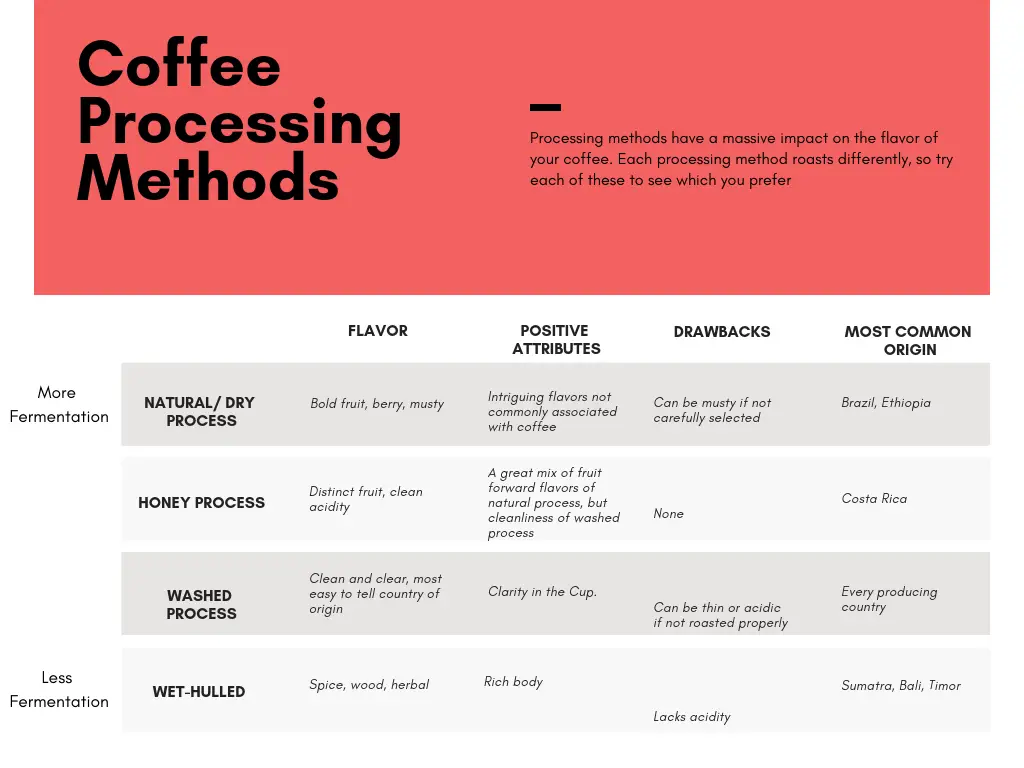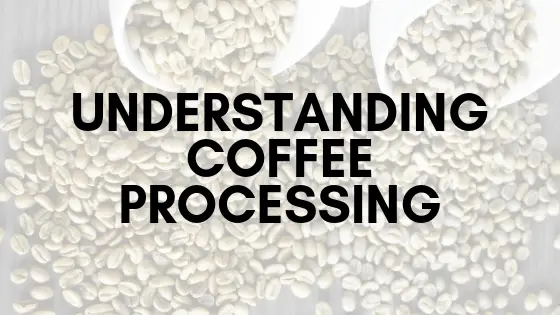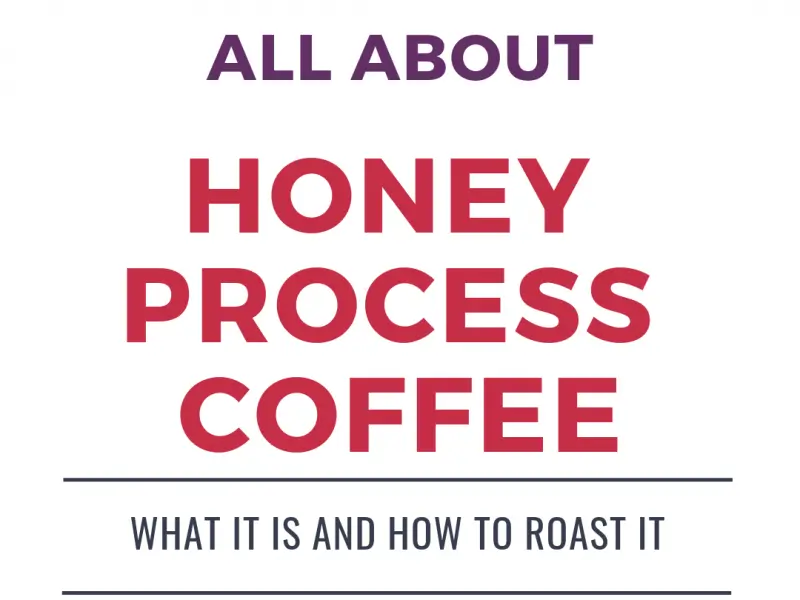What is Coffee Processing?
Coffee starts its life as a seed in a coffee cherry. Farmers around the world have different methods for extracting that seed and drying it for export. These different methods of fermenting and drying the coffee seed is what we call processing.
There are 3 major types of coffee processing methods that you’ll find as a home roaster, and a few new and innovative methods you might see as well.
Let’s go over what happens during coffee processing and how the processing method affects your roast and the final flavor in the cup.

Washed Process Coffee
Washed process coffee is by far the most widely used method in specialty coffee. Washed process coffees have cleaner and clearer flavors than their natural or dry process coffee counterparts.
Here’s why:
Washed Process Method
After the coffee cherries are picked, they are rinsed and sorted. Unripe, or otherwise damaged cherries are often discarded. The cherries are then fermented in large tanks of turbulent water. This allows the skin and pulp of the cherry to separate from the seed.
After enough fermentation, the skin and pulp, or ‘mucilage,’ is removed from the seed and the seeds are dried.
This fermentation doesn’t take long and because of that, not much of the coffee fruit flavor is transferred into the seed.
Washed Process Flavor
Because washed processed coffee is removed from the fruit early, it has an exceptionally clean flavor. These coffees tend to be thinner in body, but do not contain some of the musty, rustic flavors of wet-hulled or natural process coffee.
Whatever flavor you get in the cup comes solely from whatever nutrients and environmental factors went into the coffee bean as it was growing. This allows you to truly taste the flavor of the region, soil, and climate as there are fewer flavors, good or bad, that can be attributed to processing method and handling.
What coffees are washed process?
Most specialty coffees you find are washed process coffees. It’s the most common method among specialty coffee growers and has been rewarded by buyers.
Roasting Washed Process coffee
While you always should take into account bean density when roasting your coffee, washed process generally accepts more heat up front than natural or wet-hulled coffees. Washed process coffees can handle a wider variety of roast profiles and respond very well to different roast levels.
Because washed process coffees are a bit thinner in body, you can try to highlight the bright, clean acidity with a lighter roast. If you’re looking to balance that acidity, you can push them further along in roast level, and they’ll still have a relatively clean flavor.
Natural Process Coffee
Natural process coffee was at one point the most common method of fermenting and drying coffee beans. The natural process is the simplest to understand and is the oldest way of drying coffee. This is also called dry process, too, so don’t be confused by these interchangeable terms.
Natural Process Method
The coffee fruit is picked from shrubs and left out to dry on large beds under the sun. Because natural process coffees require an extended drying period, the climate of the region must have dry seasons where rain and moisture won’t come along and ruin a crop.
Farmers and processors come along and turn the fruits regularly as they ferment and dry. Eventually, the cherries go from bright red and yellow to dark brown and shriveled, like dried prunes.
At this point, the fruit and pulp is removed, and the coffee seed is left to fully dry for export.
Natural Process Flavor
Natural process coffees are a bit wilder in flavor. The first cup of coffee that truly changed my perspective on what’s possible in coffee and got me hooked on home roasting was a Natural Ethiopian. However, most commodity grade coffees are also Natural process, simply because it’s the easier to mass produce.
So you have to be careful with natural process coffees. If you’re buying from a home roaster supply, they’ve already done the cupping and selecting for you: the natural process coffee you get from them will almost certainly be delicious.
Natural process coffees pick up a lot of flavor from the coffee cherry itself, leading to intense fruit flavors in the cup. If you’ve ever had an Ethiopian natural, you may have been surprised that your cup of coffee tasted like a slice of blueberry pie. That’s the effect of the natural process!
What coffees are natural process?
Most coffees from Brazil, unless otherwise noted, are natural process. There are also many naturally processed coffees from Ethiopia. Again, if you’re buying from a reputable seller like Sweet Maria’s, you’re only going to get great coffee, so you don’t have to worry too much about the musty, off flavors.
Roasting Natural Process Coffee
Natural process coffee requires a slightly lower and slower roasting method. If you roast too quickly, those extra sugars present in the bean can lend a bitter and acrid flavor. I like to keep naturals on the lighter end of the roast spectrum as you can highlight their acidity and the roasting moves along much faster.
If you roast by temperature, you’ll find that naturally processed coffees come out darker than their washed process counterparts. Natural process coffees also produce a lot more chaff when roasting, so take that into account, especially if you’re roasting inside your home.
Wet Hulled Coffee
Wet hulling is a throwback to the Dutch colonies in Indonesia, where the process is still used frequently. More farmers and processors are moving toward standard washed process coffees, but wet-hulling imparts a certain flavor that has become linked with Indonesian coffees.
Wet Hulled Method
In both washed and natural process methods, the skin is left on for a period of fermentation. In the wet hulled method, the skin is removed first in a hand cranked machine. After the skin is removed, the coffee is left to ferment overnight in its mucilage.
After this brief period of fermentation, the mucilage is washed off. The coffee seed is left inside it’s parchment, which is a sort of protective coat. Most washed process coffees are left at this stage to dry enough to export, but in Indonesia where wet hulling is practiced, the coffee is only partially dried, and not nearly dried enough to export.
Because of the climate in Indonesia, farmers sell their coffee at this point to a middleman who transports the coffee to another area for further drying.
Wet Hulled Flavor
Wet hulling adds a significant amount of body to the final cup of coffee, though the flavors can be sharp. On average, they lack both the sweetness and acidity of other coffees. That being said, this processing method lends a unique characteristic that is a fun experiment for the home coffee roaster.
Roasting Wet Hulled Coffee
I always think of roasting wet-hulled coffees like this: they’ve lived a tough and rushed life up until they get to you. You should treat them gently and roast slower. For these coffees, I don’t preheat my roaster. I just let them slowly come up to temp. This will help bring out whatever sugars are present, and I’ve found that it enhances the body of the finished coffee.
Roasting slow allows for a more rich flavor, though if you push that edge too far, you’ll end up with baked flavors. However, sometimes in Indonesian coffees, baked flavors aren’t as bad as the sharp, underdeveloped flavors, so I tend toward the dark end of the spectrum.
Indonesian coffees, and wet hulled coffees, lend themselves really well to darker roasts. If you typically only roast light, give a wet hulled coffee a try and bring it into second crack. I’m sure you’ll be delighted with the change of pace.
Honey Process Coffee
Honey Process coffee is a mix between natural process and wet processing methods. It was first practiced widely in Costa Rica, though it’s now being used more frequently throughout Central and South America.
The great thing about finding a honey process coffee for sale is that you can almost guarantee that it’s top quality.
Honey processing is relatively new and was born from the economics of specialty coffee. This means that the coffee is specifically grown and processed to be sold on the basis of its excellent flavor.
Honey Process Method
There are many “styles” of honey processing, such as white honey, black honey, red honey, and so on. These are all just different degrees of the same process. White honey, for instance, is fermented for less time than black honey process. Because of this, white honey will be more toward the washed process end of the spectrum, and black honey will be more toward the natural process end of the spectrum.
Roasting Honey Process Coffees
Honey process coffees are really fun to roast. This is where you get to put all of your roasting knowledge to work. Should you treat it more like a washed? Should you treat it more like a natural? It’s totally up to you.
I treat honey processed coffees more like naturals and lean toward their inherent sweetness. I still roast them light, however, because I definitely want that crisp acidity present.
Learning more about coffee processing
The only way to really understand the effect of coffee processing is to roast a lot and taste side by side. Take this article and roast along with it. Try four different coffees with different processing methods and take notes!
Sometimes, sites like Sweet Maria’s will offer two coffees from the same region and processor, but one is done washed and one is naturally processed. I highly recommend jumping on that and buying a pound of each when you see it. It’s the single greatest way to fully understand how processing affects flavor.




